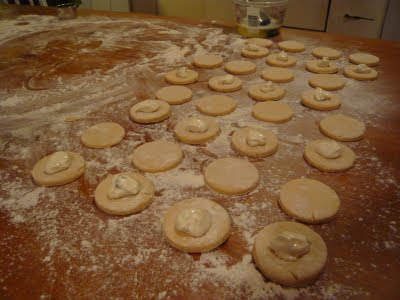The best fish and chips you will ever have is not made with fish at all, but rather a fungus-infected mushroom. The plain white mushroom, Russula brevipes, gets consumed by Hypomyces lactifluorum, which contorts the mushroom and covers it with a hard bright red-orange coating. This appearance has won it the name of Lobster Mushroom. Russulas (and close relatives) have a unique cell structure that makes them "brittle like chalk". That's not to say they are delicate, Lobster Mushrooms in particular are quite sturdy, but if you try to bend the flesh, it snaps cleanly. This also gives it a wonderful "al dente" mouth feel. Here is what a Lobster Mushroom looks like in the wild:
To make this into fish and chips just follow the standard breading procedure, which is as follows:
1) Cut item to be breaded into pieces roughly 1/4 inch thick
2) Dunk a piece into flour, pat off the excess flour.
3) Dunk the floured piece into lightly beaten eggs, allow excess egg to drip off.
4) Plop the eggy piece into some seasoned bread crumbs. Cover the piece thoroughly with bread crumbs. (Season with salt at least, feel free to have fun with herbs or spices though)
5) Immediately fry the breaded piece in bacon fat or any other oil. Cook until golden brown!
Here's the logic behind the standard breading procedure if you're curious - The flour absorbs any natural moisture (this is incredibly helpful for breading meats that are naturally quite moist). Egg is essentially edible glue that can be used to stick dry things together, in this case, the egg is holding together the flour and bread crumbs while the flour is stuck to your food item. Then as you cook the breaded item, the egg works to cement everything together.
Now for the Chips part of Fish & Chips.
Olsen Farm sells some amazing potatoes, in particular, the Bintje variety makes amazing fries! We just slice them up and fry them in bacon fat. Minimal turning/stirring helps to give them a nice crisp texture.



















